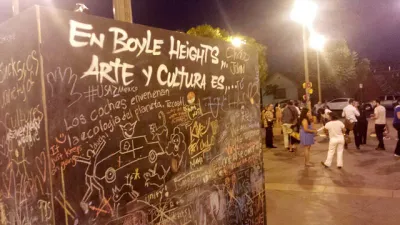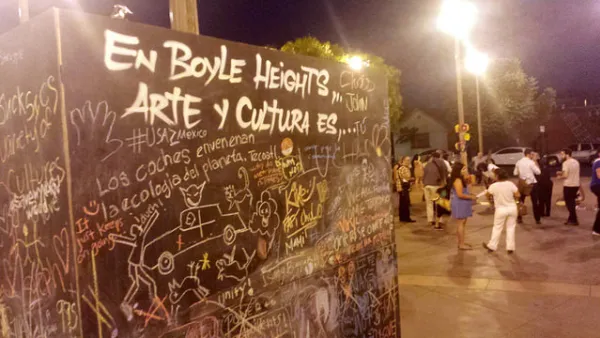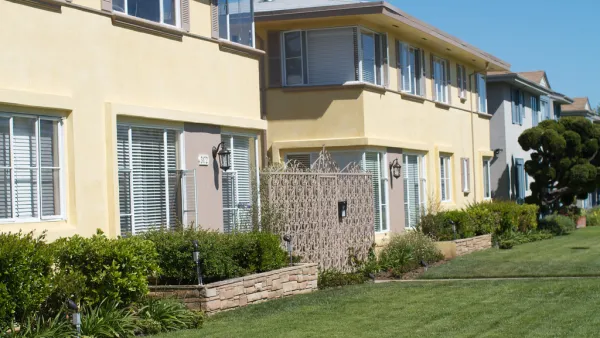The landscape of community development in Los Angeles today differs vastly from even a few years ago. Two groups in East L.A. are developing solutions to accelerating gentrification and displacement and a compounding affordable housing crisis.

Just last month, Rudy Espinoza, executive director of Leadership for Urban Renewal (LURN), shared his experience during the tumultuous situation in Boyle Heights via a blog post titled: "On Defending Boyle Heights." Boyle Heights has recently been the frontline of gentrification and community groups have pushed back from all directions. Over the last decade, the East LA Community Corporation (ELACC) has pushed regional authorities to better engage with low-income communities of color through policy advocacy, defending those who bear the brunt of these development and environmental changes.
Joining The Planning Report for an interview, Rudy sat down with East LA Community Corporation (ELACC) President Isela Gracian to discuss their work on creating a forward-looking community plan for Boyle Heights that protects residents and reflects local needs. They also outline opportunities for innovation in planning, policy, and finance that could help deliver transformative resources to L.A.'s underserved neighborhoods.
Amongst the issues facing the landscape of community development in Los Angeles today are vastly different from even a few years ago. Redevelopment agencies are no longer a resource; the city's planning process is widely agreed to be in crisis; and Los Angeles Metropolitan Transportation Authority has taken on neighborhood-level development alongside its rapid rail expansion.
Gracian, who joined ELACC in 2004, reinforced the importance of having the city of L.A.'s Planning Department strengthen its engagement in community planning. ELACC also focuses on a targeted acquisition strategy in anticipation of the Gold Line extension into East L.A. As of now, ELACC has five developments along the Gold Line that are within comfortable walking distance of a train station. Gracian explains that "as the system expands, similar opportunities will become available in other communities. It’s critical that Metro include strong policies encouraging the development of affordable housing in neighborhoods where that is needed."
Both organizations have used innovative measures to organize support and raise awareness. Gracian and ELACC brought residents to the conversation over a Boyle Heights Community Plan by creating a People's Plan for Boyle Heights and helped transform the tools they were using to engage residents—for instance, by using Legos to demonstrate height and Floor-Area Ratio (FAR). The city's Planning Commission has since adopted the practice as a way to engage more community members.
But how are we going to finance affordable housing for communities on the front-line of gentrification? Espinoza, an urban planner by trade, is having LURN work with ELACC to find alternative financing methods to help people own property. As Espinoza states, "we need to think creatively about how to acquire property that’s community-oriented, and whose management is driven by the needs of the people."
Gracian shares that in ELACC’s work around wealth building, they have found that when low-income families purchase a home—particularly Latino and black families—they tend not to treat it as a "transitional investment." Using that as ELACC's frame of reference allows "for a diversity of homeowners, tenants, business owners, and landowners. Our process has been very successful in bringing those diverse groups together to identify the core issues in the neighborhood and to share their opinions," as Gracian explains.
Read more about how ELACC and LURN are organizing and finding success in working to advance public transportation, community wealth-building, and affordable housing in East Los Angeles in The Planning Report.

Analysis: Cybertruck Fatality Rate Far Exceeds That of Ford Pinto
The Tesla Cybertruck was recalled seven times last year.

National Parks Layoffs Will Cause Communities to Lose Billions
Thousands of essential park workers were laid off this week, just before the busy spring break season.

Retro-silient?: America’s First “Eco-burb,” The Woodlands Turns 50
A master-planned community north of Houston offers lessons on green infrastructure and resilient design, but falls short of its founder’s lofty affordability and walkability goals.

Test News Post 1
This is a summary

Analysis: Cybertruck Fatality Rate Far Exceeds That of Ford Pinto
The Tesla Cybertruck was recalled seven times last year.

Test News Headline 46
Test for the image on the front page.
Urban Design for Planners 1: Software Tools
This six-course series explores essential urban design concepts using open source software and equips planners with the tools they need to participate fully in the urban design process.
Planning for Universal Design
Learn the tools for implementing Universal Design in planning regulations.
EMC Planning Group, Inc.
Planetizen
Planetizen
Mpact (formerly Rail~Volution)
Great Falls Development Authority, Inc.
HUDs Office of Policy Development and Research
NYU Wagner Graduate School of Public Service




























